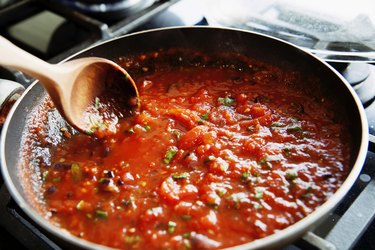
For many cooks and gardeners the high point of summer is the sudden flood of fresh-picked, vine-ripened tomatoes. A few days spent cooking, canning and freezing can provide a whole year's worth of canned tomatoes, salsa or your favorite tomato sauce. Freezing tomato sauces for long-term storage requires sealing out the air that causes freezer burn. There are many other practical considerations that affect your choice of container.
Desirable Characteristics for Storage Containers
Video of the Day
Aside from the ability to seal the sauce airtight, there are a number of other characteristics that make an ideal storage container. The best containers come in multiple sizes to allow for larger and smaller meals. They should be square or rectangular to make the best use of freezer space and flat on top to allow for stacking. Ideally, they should be able to go from freezer to microwave for reheating and should be dishwasher safe. The lids also should be able to withstand heating and machine washing without warping and losing their ability to seal.
Video of the Day
Freezer Bags Have Limited Viability
Heavy-duty freezer bags are a widely used choice for frozen foods of all kinds. Their two advantages are low cost and their ability to expel most or all of the air inside the package before it's frozen. Some varieties are designed to stand up straight when opened, making them easier to fill. However, bags have many shortcomings. They cannot be used for reheating and can't be reused. They also do not provide neat storage in the freezer, which reduces the amount of usable storage space.
Plastic Containers and Stains
Plastic containers offer many advantages for freezing tomato sauce. They are space-efficient, can be very good at locking out air and can go from the freezer to the microwave with varying degrees of efficiency. However, most varieties do have shortcomings. Almost all plastic containers are permanently stained by tomatoes, even after washing. When frozen, many containers are brittle and will break or shatter if dropped. They also are prone to warping after going through the microwave or dishwasher, which compromises their ability to seal foods properly in future.
Glass Containers Work Best
Leading glassware manufacturers now offer a variety of tempered glass storage/cooking containers with plastic lids for sealing. These are higher in cost than plastic containers but have some significant advantages. Glass is not stained by tomatoes as plastic is, so it retains its original appearance for longer. The containers can be microwaved and can also be used in the oven. The lids seal out air just as well as those of plastic containers. However glass is heavier and will break if dropped, and the lids are just as prone to warping and staining as those of plastic containers. Don't fill the jar to the top as the sauce expands as it freezes.
Freezing Tomato Sauce
No one container combines all the desirable characteristics, so each cook must make a decision based on his or her own preferences. Plastic freezer containers vary widely in quality, so it is worthwhile to compare several brands for durability and stain resistance. Several publications and consumer organizations make that kind of information available. It also is possible to combine packaging options by freezing the sauce in containers and then bagging the frozen blocks or by placing full bags of sauce in plastic or glass containers for added protection and convenient stacking.